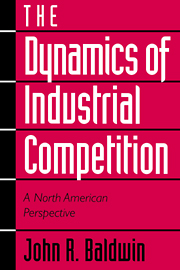Book contents
- Frontmatter
- Contents
- preface
- Acknowledgements
- 1 The dynamics of competition
- 2 Greenfield entry and closedown exit
- 3 Entry, exit, and the merger process
- 4 The rise and fall of incumbents
- 5 Patterns of large- and small-firm mobility
- 6 Plant turnover in Canada and the United States
- 7 Measures of market structure and the intensity of competition
- 8 The relationship between mobility and concentration
- 9 Turnover and productivity growth
- 10 Merger success
- 11 Turnover in domestic and foreign enterprises
- 12 Industry efficiency and firm turnover in the Canadian manufacturing sector
- 13 Firm turnover and profitability
- 14 Modelling entry
- 15 Conclusion
- Appendix A Measuring firm turnover – methodology
- Appendix B Definition of concentration and mobility measures
- Notes
- References
- Author index
- Subject index
13 - Firm turnover and profitability
Published online by Cambridge University Press: 30 March 2010
- Frontmatter
- Contents
- preface
- Acknowledgements
- 1 The dynamics of competition
- 2 Greenfield entry and closedown exit
- 3 Entry, exit, and the merger process
- 4 The rise and fall of incumbents
- 5 Patterns of large- and small-firm mobility
- 6 Plant turnover in Canada and the United States
- 7 Measures of market structure and the intensity of competition
- 8 The relationship between mobility and concentration
- 9 Turnover and productivity growth
- 10 Merger success
- 11 Turnover in domestic and foreign enterprises
- 12 Industry efficiency and firm turnover in the Canadian manufacturing sector
- 13 Firm turnover and profitability
- 14 Modelling entry
- 15 Conclusion
- Appendix A Measuring firm turnover – methodology
- Appendix B Definition of concentration and mobility measures
- Notes
- References
- Author index
- Subject index
Summary
There is no more important proposition in economic theory than that, under competition, the rate of return on investment tends toward equality in all industries.
George Stigler (1963: 54)Introduction
Few other topics have received as much attention in applied studies in the field of industrial economics. Despite the large number of studies in this area, few attempts have been made to measure the dynamics of the equilibration process and to relate them to specific industry characteristics.
Previous chapters have developed comprehensive measures of competitiveness and have examined the relationship between measures of competitiveness and measures of performance such as industry productivity or efficiency. This chapter explores the relationship between competitiveness and profitability.
The investigation focuses on three issues. The first is the degree to which profitability in various industries equates over time. The second is the extent to which differences in profitability are related to measures of firm turnover. The third is whether the speed with which industries regress to the mean is related to measures of industry turnover.
Profitability and competition
Previous studies
Studies of industry profitability have focused on the extent of crossindustry differences in profitability levels at a point in time and the degree to which these differences are perpetuated over time.
Stigler (1963) examines the time path of rates of profitability by correlating industry rates of return over time and reports that inter-industry rankings based on profitability changed slowly. The correlation between successive years for 99 manufacturing industries in the United States was .69 in 1946–47 and had increased to .79 by 1956–57.
- Type
- Chapter
- Information
- The Dynamics of Industrial CompetitionA North American Perspective, pp. 328 - 359Publisher: Cambridge University PressPrint publication year: 1995



